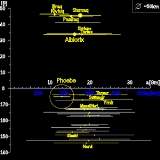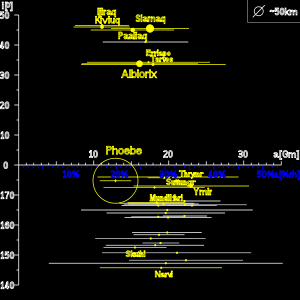
Saturn's Norse group of satellites
Encyclopedia
The Norse group is a large group of retrograde
irregular satellite
s of Saturn
. Their semi-major axes
range between 12 and 24 Gm, their inclination
s between 136° and 175° and their eccentricities between 0.13 and 0.77.
 Unlike for the Inuit and Gallic groups, the orbital parameters are widely dispersed and group is likely to be composed from a number of sub-groups with more homogenous orbital and physical parameters. For example, the satellites with inclinations around 174 degree alone are though to be built with at least two sub-groups.
Unlike for the Inuit and Gallic groups, the orbital parameters are widely dispersed and group is likely to be composed from a number of sub-groups with more homogenous orbital and physical parameters. For example, the satellites with inclinations around 174 degree alone are though to be built with at least two sub-groups.
Eight other moons form the Skathi subgroup. Their semi-major axes
range between 15 and 20 Gm, their inclination
s between 147° and 158°. Narvi forms a separate sub-group with Bestla.
The diagram illustrates the Norse group in relation to other irregular satellites of Saturn. The eccentricity of the orbits is represented by the yellow segments (extending from the pericentre
to the apocentre
) with the inclination represented on Y axis.
The members of the group are (in order of increasing distance from Saturn):
The International Astronomical Union
(IAU) reserves names taken from Norse mythology
(mostly giants) for these moons. The exception is Phoebe, the largest, which was discovered long before the others.
Retrograde motion
Retrograde motion is motion in the direction opposite to the movement of something else, and is the contrary of direct or prograde motion. This motion can be the orbit of one body about another body or about some other point, or the rotation of a single body about its axis, or other phenomena such...
irregular satellite
Irregular satellite
In astronomy, an irregular moon is a natural satellite following a distant, inclined, and often eccentric and retrograde orbit. They are believed to have been captured by their parent planet, unlike regular satellites, which form in situ....
s of Saturn
Saturn
Saturn is the sixth planet from the Sun and the second largest planet in the Solar System, after Jupiter. Saturn is named after the Roman god Saturn, equated to the Greek Cronus , the Babylonian Ninurta and the Hindu Shani. Saturn's astronomical symbol represents the Roman god's sickle.Saturn,...
. Their semi-major axes
Semi-major axis
The major axis of an ellipse is its longest diameter, a line that runs through the centre and both foci, its ends being at the widest points of the shape...
range between 12 and 24 Gm, their inclination
Inclination
Inclination in general is the angle between a reference plane and another plane or axis of direction.-Orbits:The inclination is one of the six orbital parameters describing the shape and orientation of a celestial orbit...
s between 136° and 175° and their eccentricities between 0.13 and 0.77.

Eight other moons form the Skathi subgroup. Their semi-major axes
Semi-major axis
The major axis of an ellipse is its longest diameter, a line that runs through the centre and both foci, its ends being at the widest points of the shape...
range between 15 and 20 Gm, their inclination
Inclination
Inclination in general is the angle between a reference plane and another plane or axis of direction.-Orbits:The inclination is one of the six orbital parameters describing the shape and orientation of a celestial orbit...
s between 147° and 158°. Narvi forms a separate sub-group with Bestla.
The diagram illustrates the Norse group in relation to other irregular satellites of Saturn. The eccentricity of the orbits is represented by the yellow segments (extending from the pericentre
Apsis
An apsis , plural apsides , is the point of greatest or least distance of a body from one of the foci of its elliptical orbit. In modern celestial mechanics this focus is also the center of attraction, which is usually the center of mass of the system...
to the apocentre
Apsis
An apsis , plural apsides , is the point of greatest or least distance of a body from one of the foci of its elliptical orbit. In modern celestial mechanics this focus is also the center of attraction, which is usually the center of mass of the system...
) with the inclination represented on Y axis.
The members of the group are (in order of increasing distance from Saturn):
- PhoebePhoebe (moon)Phoebe is an irregular satellite of Saturn. It was discovered by William Henry Pickering on 17 March 1899 from photographic plates that had been taken starting on 16 August 1898 at the Boyden Observatory near Arequipa, Peru, by DeLisle Stewart...
- SkathiSkathi (moon)Skathi , or Saturn XXVII, is a natural satellite of Saturn. It was discovered by Brett Gladman, Kavelaars, et al. in 2000, and given the temporary designation S/2000 S 8....
(Skathi subgroup) - S/2007 S 2S/2007 S 2S/2007 S 2 is a natural satellite of Saturn. Its discovery was announced by Scott S. Sheppard, David C. Jewitt, Jan Kleyna, and Brian G. Marsden on May 1, 2007, from observations taken between January 18 and April 19, 2007....
- Skoll (Skathi subgroup)
- Greip
- Hyrrokkin (Skathi subgroup)
- S/2004 S 13S/2004 S 13S/2004 S 13 is a natural satellite of Saturn. Its discovery was announced by Scott S. Sheppard, David C. Jewitt, Jan Kleyna, and Brian G. Marsden on May 4, 2005 from observations taken between December 12, 2004 and March 9, 2005....
- S/2004 S 17S/2004 S 17S/2004 S 17 is a natural satellite of Saturn. Its discovery was announced by Scott S. Sheppard, David C. Jewitt, Jan Kleyna, and Brian G. Marsden on May 4, 2005 from observations taken between December 13, 2004 and March 5, 2005....
- Jarnsaxa
- MundilfariMundilfari (moon)Mundilfari , or Saturn XXV, is a natural satellite of Saturn. It was discovered by Brett J. Gladman, et al. in 2000, and given the temporary designation S/2000 S 9....
- S/2006 S 1S/2006 S 1S/2006 S 1 is a natural satellite of Saturn. Its discovery was announced by Scott S. Sheppard, David C. Jewitt, Jan Kleyna, and Brian G. Marsden on June 26, 2006 from observations taken between January 4 and April 30, 2006....
(Skathi subgroup) - NarviNarvi (moon)Narvi , or Saturn XXXI, is a natural satellite of Saturn. It was discovered by a team of astronomers led by Scott S. Sheppard in 2003, and given the temporary designation S/2003 S 1.- Description :...
(Narvi subgroup) - Bergelmir (Skathi subgroup)
- SuttungrSuttungr (moon)Suttungr , or Saturn XXIII, is a natural satellite of Saturn. It was discovered by Brett J. Gladman, et al. in 2000, and given the temporary designation S/2000 S 12...
- S/2004 S 12S/2004 S 12S/2004 S 12 is a natural satellite of Saturn. Its discovery was announced by Scott S. Sheppard, David C. Jewitt, Jan Kleyna, and Brian G. Marsden on May 4, 2005 from observations taken between December 12, 2004 and March 9, 2005....
- S/2004 S 7S/2004 S 7S/2004 S 7 is a natural satellite of Saturn. Its discovery was announced by Scott S. Sheppard, David C. Jewitt, Jan Kleyna, and Brian G. Marsden on May 4, 2005 from observations taken between December 12, 2004 and March 8, 2005....
- Hati
- Bestla (Narvi subgroup)
- Farbauti (Skathi subgroup)
- Thrymr
- S/2007 S 3S/2007 S 3S/2007 S 3 is a natural satellite of Saturn. Its discovery was announced by Scott S. Sheppard, David C. Jewitt, Jan Kleyna, and Brian G. Marsden on May 1, 2007 from observations taken between January 18 and April 19, 2007....
- Aegir
- S/2006 S 3S/2006 S 3S/2006 S 3 is a natural satellite of Saturn. Its discovery was announced by Scott S. Sheppard, David C. Jewitt, Jan Kleyna, and Brian G. Marsden on June 26, 2006 from observations taken between January and April 2006....
(Skathi subgroup) - Kari (Skathi subgroup)
- Fenrir
- Surtur
- YmirYmir (moon)Ymir , or Saturn XIX, is a retrograde irregular moon of Saturn. It was discovered by Brett J. Gladman, et al. in 2000, and given the temporary designation S/2000 S 1...
- Loge
- Fornjot
The International Astronomical Union
International Astronomical Union
The International Astronomical Union IAU is a collection of professional astronomers, at the Ph.D. level and beyond, active in professional research and education in astronomy...
(IAU) reserves names taken from Norse mythology
Norse mythology
Norse mythology, a subset of Germanic mythology, is the overall term for the myths, legends and beliefs about supernatural beings of Norse pagans. It flourished prior to the Christianization of Scandinavia, during the Early Middle Ages, and passed into Nordic folklore, with some aspects surviving...
(mostly giants) for these moons. The exception is Phoebe, the largest, which was discovered long before the others.
External links
- S. Sheppard's classification of Saturn's irregular moons

